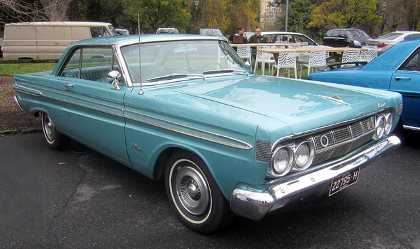How Robert Kearns Took on Ford and Chrysler and Won
Robert Kearns invented and patented the intermittent windshield wiper only to see his invention show up in Ford, Chrysler and Mercedes-Benz cars. Then he got mad.
The story of the lone inventor has shaped our understanding of the industrial revolution and the information age. We’ve all heard the stories of Thomas Edison working tirelessly to perfect his light bulb, and Steve Wozniak pouring over schematics to create the Apple computer.
RELATED: 24 INVENTIONS BY WOMEN YOU MIGHT NOT BE AWARE OF
We also know the fame and fortune these inventors have received as a result of their hard work and ingenuity. But, what happens when an inventor creates a useful invention, patents it, and tries to sell it, only to see his invention stolen by the very companies he tried to sell it to?
In 1953, newly graduated mechanical engineer Robert William Kearns and his new wife Phyllis, were on their honeymoon in Ontario, Canada. During a celebration, a champagne bottle was opened, and its cork flew across the room, striking Kearns in the left eye. The accident caused Kearns to lose most of the vision in that eye.
During his recuperation, Kearn began thinking about the mechanics of the eye, and especially about the eyelid. An eyelid doesn’t blink at a predetermined rate, but rather moves when the eye is dry or when a foreign object, such as dust, lands on the surface of the eye.
Kearns reasoned that the windshield wiper of a car should act like an eyelid, altering its wiping rate as the rain and road conditions changed.
Ten Years of Tinkering
For the next ten years, Kearns developed and refined his new intermittent windshield wiper concept. Building a laboratory in his basement, he constructed models using the dashboards of salvaged cars to test and refine his invention.
In 1963, Kearns retrofitted his intermittent windshield wiper onto a running Ford Galaxie convertible, and drove it to the Ford factory in Dearborn, Michigan. Ford was one of the “big three” automobile manufacturers, along with General Motors and Chrysler.
According to Kearns, the Ford managers he met with that day seemed interested in his invention, but were noncommittal. They did, however, call him in for a second meeting.
At this second meeting at Ford, Kearns was greeted by a phalanx of engineers, eager to question him on his intermittent windshield wiper, and to show him, albeit at a distance, an intermittent windshield wiper system of their own. Ford was planning on installing intermittent windshield wipers in its Mercury line of cars.

Feeling a kinship with his fellow engineers, and thinking a deal with Ford was in the offing, Kearns revealed many of the inner workings of his wiper design to the Ford engineers.
Two Years Go By
For the next two years, Kearns met periodically with groups of Ford engineers to discuss intermittent wiper technology, but no offer was made to him to license his technology, or to partner with him in any way. Then, at the end of 1965, Ford stopped calling Robert Kearns altogether.
In 1969, the Ford Motor Company introduced the first electronic intermittent windshield wiper. Kearns, still believing that a deal with Ford was possible, and that Ford was acting in good faith, didn’t question Ford’s intentions until 1976.
A Shocking Discovery
Kearns spent the early 1970s working as an engineer at the U.S. National Bureau of Standards, and his intermittent windshield wiper was put on the back burner. Then, in 1976, Kearns’ eldest son, Dennis Kearns, acquired an intermittent wiper control box used by Mercedes-Benz. Reverse engineering the Mercedes box, Kearns realized that the design was a literal copy of his patented invention.
Pouring over the patent filings from Ford, Volkswagen, Renault, General Motors, Mercedes-Benz and others, Kearns recognized that they had all simply copied and pasted several key elements of his design and incorporated them into their own patent filings.
Kearns was crushed and angry that companies he had admired his whole life were stealing from him without regard for his rights as the patent holder for the invention of the intermittent windshield wiper. Kearns described the companies’ behavior as, “Bob Kearns doesn’t count. He’s nothing. He doesn’t exist.”
Kearns Fights Back
From 1977 onward, Kearns referred to his occupation as “litigant.” He filed lawsuits against Ford, Chrysler, General Motors, and several European carmakers, including Mercedes-Benz.
As the legal cases worked their way through the courts, the stress on Kearns and his family mounted. He suffered a nervous breakdown and spent several weeks in a hospital. His long marriage to wife Phyllis ended.
The financial cost of taking on the auto giants weighed heavily on Kearns, and in several cases, he represented himself in court. This may have lead to the dismissal of a number of cases due to missed deadlines, and a lack of court-ordered filings being presented to the court.
And the Decision Is …
Finally, in 1990, after more than a decade in the legal system, the Ford Motor Company agreed to settle with Robert Kearns for $10.2 million. In 1992, Kearns won a judgment against Chrysler for $30 million. Chrysler appealed the decision, but it was upheld when the U.S. Supreme Court refused to hear Chrysler’s appeal.
In 2005, Robert Kearns died of brain cancer. In 2008, Universal Pictures released the film “Flash of Genius,” a retelling of Kearns’ story that starred Greg Kinnear as Kearns.
Robert Kearns may not be remembered solely as the inventor of the intermittent windshield wiper, but as a “little guy” who fought back against large, powerful corporations and won.
 SHOW COMMENT ()
SHOW COMMENT ()










